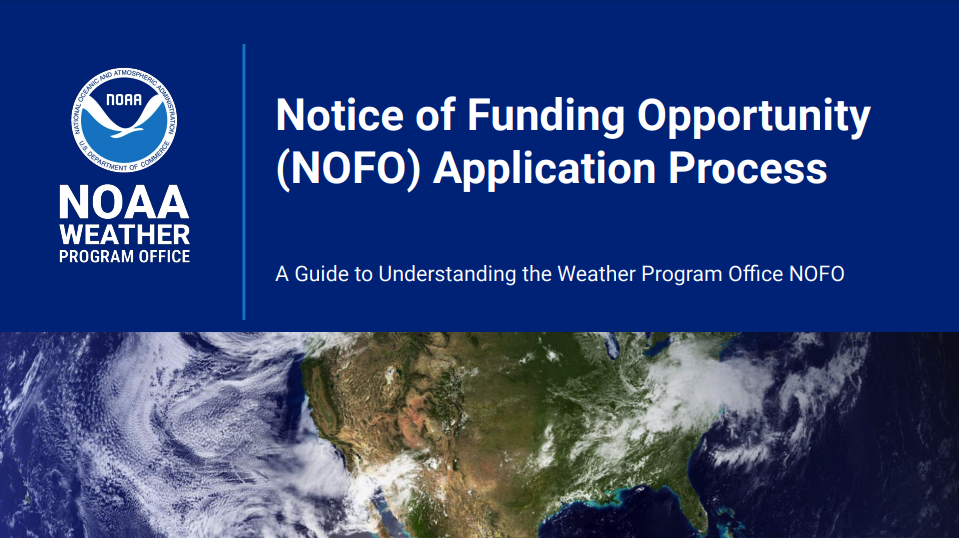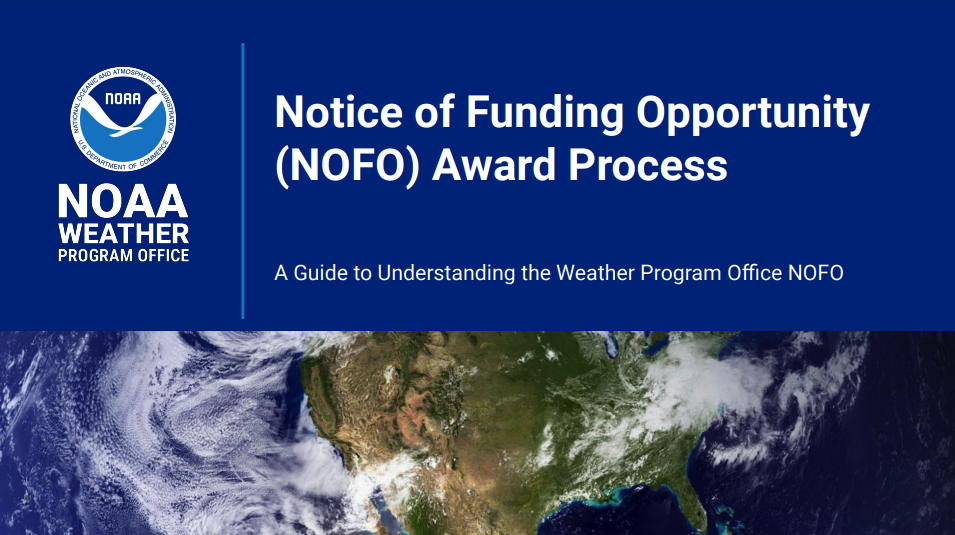"To ensure compliance with Executive Order 14151, the Weather Program Office is excluding statements and factors related to diversity, equity, inclusion, and accessibility (DEIA) from the evaluation of proposals received under the FY25 Notices of Funding Opportunity. Any DEIA-related application components are no longer required and, for letters of intent or proposals already submitted, will be disregarded in the scoring and selection of proposals".
Download the NOFO Application Process Guide
Download the NOFO Award Process Guide
Applicant Checklist
Proposal Format
All pages should be single-spaced and set in 12-point font with one-inch margins on 8 ½ x 11 inch paper. The proposal should be submitted as a PDF file. It must be dated and display page numbers. The final proposal must include the following items that are described below in the checklist. Please refer to the FY25 Annual Notice of Funding through Grants.gov to see the full proposal guide and instructions for how to apply with the most robust information for each topic.
Project Narrative
Title Page
- For each PI, co-PI, and co-Investigator (co-I) as well as each respective institutional representative, include their full name, title, organization, telephone number, email address; the mailing address for the institution’s Lead PI;
- The total requested funds for each annual period for the project as a whole, and for each individual institution For joint projects with multiple institutions, the names of all institutions along with their PI information and total requested funding for each annual period for each institution must appear on the title page of each of the separate applications. A second title page that does not count against the proposal page limit may be added to accommodate the information. (including each internal federal and external non-federal institution), including indirect costs;
- The Funding Opportunity Number, NOFO Competition to which the proposal is applying, and the relevant competition’s priority(ies); and
- The starting and ending Readiness Levels (RLs).
Abstract
The abstract must appear on a separate one page document. Instead of using a single paragraph format to write the body of your abstract, we ask that you provide a concise response to several prompts. Each response should be a maximum of 50 words (not to exceed 1-2 sentences). Please ensure your descriptions are clear, concise, and informative. If funded, NOAA may, at its own discretion, make publicly visible the abstract or components of it to increase public awareness of research knowledge. Therefore, avoid technical jargon, use plain-language, and focus on the key points that highlight the significance and impact of your project. Please provide concise responses to the following prompts:
- Project Goal: Describe the primary goal or purpose of the project.
- Problem/Opportunity Statement: Explain the specific operational problem you are aiming to address or the opportunity you are exploring.
- Methodology/Activities to be Performed: Summarize the approach, methods, or activities you will use to conduct the research.
- Primary Project Products/Outputs: Describe the main output(s) or product(s) you expect to result from your project.
- Expected Results, Outcomes, and Benefits: Outline the expected results and outcomes of this project, as well as the intended operational and/or societal benefits.
- Intended Beneficiaries and Recipients: Include who you anticipate will use the outputs and how they will (or may) be applied.
Problem Statement
Identify the problem and/or the opportunity and its relevance to one or more of the competition’s science priorities identified in Section I.B. Please reference the priorities listed under this competition. If appropriate, concisely cite results from prior relevant research and/or previously-funded NOAA projects that contributed to the proposed research concept, and if applicable, provide the NOAA project award number, title, and period of performance for any previously-funded NOAA projects performed either by you or other researchers. Additionally, please indicate if a NOAA Transition Plan has been developed for earlier work on this topic.
Methods and Activities
Concisely describe the method(s) and key activities that will be conducted to successfully complete the project. This may include information on model frameworks, simulations, HPC availability, data collection, analysis, collaborations needed (including needed operational collaborations for transition), and necessary travel Applicants are encouraged to consider contingencies in the event of scenarios that restrict travel, such as those resulting from the COVID-19 pandemic. (associated with data collection, project meetings, testbed planning meetings, testbed experiments, and the presentation of results at scientific conferences, as appropriate). Applicants are encouraged to consider contingencies in the event of scenarios that restrict travel or completion of other project activities, such as those resulting from the COVID-19 pandemic.
If applicable, the methods section should also include information on:
- Institutional Review Board (IRB): Applicants submitting proposals that involve the use of human subjects should state so clearly in their Methods, and also include appropriate milestones in the schedule for completion of the IRB process. If the recipient seeks agency assistance conducting or sponsoring any collection of information, Office of Management and Budget (OMB)/Paperwork Reduction Act (PRA) clearance will be needed. Applicants should take this factor into account in planning their project. Additional information about requirements for the inclusion of human subjects, including applicability to focus groups and testbed experiments, can be found in the General Information Sheet;
- High-performance computing (HPC): The availability of HPC the project has access to ensure success; and
- Use of Testbeds: Any proposed testing in one or more of the NOAA Testbeds.
Products/Outputs
- Identify the primary planned products/outputs. Outputs could include, but are not limited to: research-guided recommendations, methodologies, tools, software applications, algorithms, other technologies, knowledge to enhance a product or service, training materials such as user manuals, guidance and other documentation, data sets, code, and outreach materials.
- Provide the current/starting and target/project-completion readiness levels (RLs) with an explanation of how each level was determined.
Impacts/Benefits/Outcomes
- Clearly describe the planned impacts, benefits, and outcomes of the project.
- Specify the weather enterprise groups or organizations e.g., local weather or river forecast offices, a national operational forecast center, community code repository, a state mesonet, a commercial organization. that will be the ultimate recipient(s), beneficiary(ies), or end users of the projects’ outputs and outcomes
- Include any relevant metrics or success indicators as appropriate.
Schedule
Provide a table or chart with a schedule for completing key milestones, products/outputs, and expected progression of or iteration through RLs.
Outreach and Education
- Describe how the project team plans to share project progress and results with the scientific community and/or general public, including but not limited to, publications, presentations, websites, hosting workshops, developing training materials, code repositories, or other engagement activities.
- Also describe any activities that promote the education and field experience of undergraduate and graduate students, and/or provide opportunities to share with K-12 students and educators, as well as any educational scholarship or internship opportunities presented by this project.
Data and/or Software Management Plan
Proposals submitted in response to this announcement must include a Data Management Plan See Section VI.B., Administrative and National Policy Requirements, for additional information on what the plan should contain. with details on how data collected during the project will be made publicly available. Also refer to your institution’s data storing and sharing policies and regulations. In addition, if software is developed as part of the proposal, a separate Software Management Plan is required, as described in Section VI.B. The Data Management Plan and/or Software Management Plan does not count towards the 14-page proposal limit.
Other Attachments
Additional attachments described below do not count towards the 14-page count defined above. The 14-page count only applies to Sections IV.D.3.(a–i).
Budget Justification
Budget Narrative
Each individual proposal must include a Budget Justification in addition to the SF-424A Budget Information form and Project Narrative title page budget table.
The information in the Budget Narrative and the SF-424A Budget Information form must be consistent. Unlike the title page, neither the budget table in this section nor the SF-424A should include budget information for PIs or co-Is at other institutions who may be contributing to a joint project.
The Budget Narrative must include:
- A detailed itemized budget table organized by year
- A budget justification that demonstrates cost effectiveness.
This budget summary should include the PI’s scientific and technical support staff salaries and fringe benefits, facility requirements, computing and communications, supplies and travel. Only include the funding requested by the institution submitting the proposal. The information in this table must exactly match the SF-424A.
Standard Forms
Mandatory Forms
- Standard Form 424 – Application for Federal Assistance
- Standard Form 424A – Budget Information - Non-Construction Programs Applicants must use the Standard Form SF-424A Budget Information-Non Construction Programs that is contained in the standard NOAA Grants and Cooperative Agreement Package. Pay careful attention to show the yearly budget breakout on page 1A of the SF 424A for multi-year proposals.
- Standard Form 424B – Assurances – Non-Construction Program
- Form CD-511 – Certifications Regarding Lobbying
- Standard Form LLL – Disclosure of Lobbying Activities
Access the forms and view full announcements at Grants.Gov >
Observations – NOAA-OAR-WPO-2025-28602
Air Quality Research and Forecasting (AQRF) – NOAA-OAR-WPO-2025-28603
Testbeds – NOAA-OAR-WPO-2025-28601
VORTEX USA – NOAA-OAR-WPO-2025-28596
Subseasonal to Seasonal – NOAA-OAR-WPO-2025-28599
Social, Behavioral, and Economic Sciences (SBES) – NOAA-OAR-WPO-2025-28598
Other Sections
- CV for all PIs, co-PIs, and co-Is
- Current and pending financial support for each investigator
- Any relevant letters of support or funding requests
Underserved Groups Information Request: NOAA will not provide collected underserved groups information to reviewers for any purpose, including evaluation, and will not consider underserved groups information during selection. Information collected from applicants will be used to measure WPO’s progress on nurturing a diverse scientific research community. On the Underserved Group Information Request Form, please provide the following information for all named collaborators on your proposal (OMB approved for PRA under DOC generic clearance information collections, 0690- 0030 and 0690-0035).
Multi-Institution Proposals For more information about Multi-Institution Proposals, please see the FAQ Section below.
For joint projects involving applications from multiple institutions, a PI must be identified for each institution submitting an application. All applications for that project must have the same title and identify the same Lead PI, co-PIs, and co-Is on the applications’ title page. The designated Lead PI and their associated institution will then be responsible for additional documents as described in the Notice of Funding. Multi-institution collaborative proposals should include the following:
- Separate, identical proposals for each institution
- Separate budget table, justification, and SF-424A for your institution
- Summary project-total budget table (Lead-PI’s proposal only)
- NOAA Collaborator Acknowledgement Form, for NOAA federal and/or testbed collaborations
A Collaborator Acknowledgement Form should be provided by a representative of the NOAA Testbed(s) or Proving Ground(s) and included as part of any proposal requesting use of Testbed or Proving Ground resources to demonstrate proper coordination.
A Collaborator Acknowledgement Form should be completed by the following:
- One federal Co-Investigator(s) from each federal (NOAA or otherwise) laboratory, center, office, or other institution contributing to the project
- NOAA Testbed or Proving Ground Manager of each testbed or proving ground proposed to host this project’s experiment(s)
Any Testbed Collaboration Acknowledgement Form or letter of support does not count against the 14-page limit for the proposal.
eRA Best Practices
For your reference, please see this “Tips and Tricks for Successful eRA Submissions” document from the Office of the Chief Information Officer website with more information regarding eRA application submissions. For further technical assistance or questions regarding the eRA system, please visit the eRA Help Desk website.





